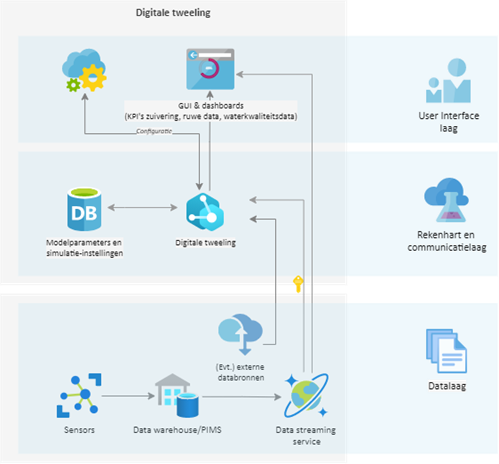Digital twin for treatment process
A digital twin provides water utilities with a firm foundation for the transition towards a (more) data-driven organisation, with prospects of optimisation, better insight or more effective management. Many organisations want to move towards a situation in which the quality of products and services are controlled more on the basis of measurements and measurable effects, than only on the basis of staff experience. To this end, a digital twin of the treatment process offers a solution, since it is mainly directed at providing a (near) real-time insight into the water quality throughout the treatment train. The roadmap being developed in the present project is intended as a guide for the rollout of such a digital twin for the treatment process and its anchoring within the organisation. Since it is being developed within the Joint Research Programme of KWR and the water utilities, it will provide for an acceleration of the transition to data-driven operational management for the sector as a whole.
Optimal operational management
A digital twin is a virtual copy or model of the reality, which replicates the physical process as closely as possible. Sensor measurements from the physical reality are fed into models of the digital twin. This data fusion of sensor data and model can in fact produce a real-time estimate of the value for parameters that are not measurable (online). These are known as virtual or soft sensors.
Furthermore, a digital twin makes it possible to calculate the optimal process settings. This is done on the basis of sensor data and model outcomes. This possibility is especially relevant when there is a need to adjust to changes, for instance, in external temperature or incoming water quality. A digital twin also offers possibilities for scenario studies. In this case the digital twin is fed with an (extreme) scenario to see how the system reacts, without influencing the physical reality.
Digital twin roadmap
A digital twin of the treatment process focusses primarily on having a (near) real-time insight into the water quality throughout the treatment train. It consists mainly of (process) models of the treatment stages, fed by data from a data management or process-information management system. This project is developing a roadmap to enable the rollout of such a digital twin. Through a review of the open literature we are building upon existing knowledge both within and outside the sector, and we are conducting interviews with experienced experts. We are defining which elements need to be taken into account in the transition to a digital twin; such as technical aspects, including the required infrastructure, (open) standards and models. In addition, we are looking at the organisational aspects related to imbedding the digital twin in the organisation.
Data-driven water utilities
With the anchoring of the development of a digital twin of the treatment process within the Joint Research Programme, important steps can be taken. Not every organisation will need to reinvent the wheel, and it will be possible to profit from each other’s efforts, for example, through the sharing of experiences or process models. This will constitute a rapid leap forward in the water sector’s transition to data-driven operational management.

Conception of a schematic representation of data streams and main functionalities of a digital twin, consisting of a data layer, a computational core and a communication layer, and a user interface. Here the users can adjust the digital twin’s user settings and parameters and show the results in (near) real-time via a dashboard.